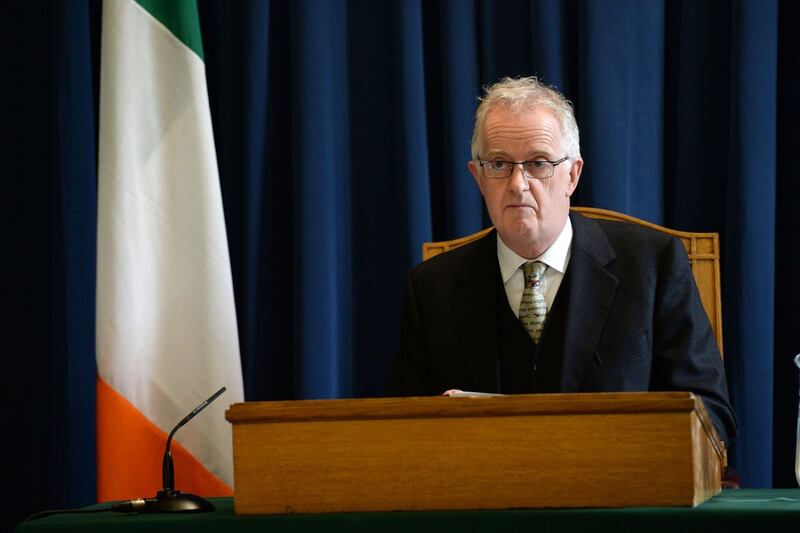For anyone brought up with the Catholic Catechism, the Charleton report brings a blast from the past. A single word, repeated more than 50 times: calumny. It is not a crime. It is a sin, and a mortal sin at that. As the Catechism puts it, “If a lie in itself only constitutes a venial sin, it becomes mortal when it does grave injury to the virtues of justice and charity.” In his remarkable report, Peter Charleton shows all the skills and wisdom of an experienced judge, but he is fundamentally concerned with a sin against Maurice McCabe that grew to be a grave injury, not only to our system of justice, but to human charity.
At one point in the report, Charleton explicitly invokes the rituals of the Catholic Church: “According to a sermon, a penitent once went to a priest for Confession. The sin was gossip. The priest suggested a penance: that the person go to the top of the church tower and tear apart a feather pillow, releasing its contents to the wind. The penitent was to return to Confession the following week. Smugly, the fulfilment of the penance was then announced. The priest said: that’s not all – now go and pick up each feather.”
Vile lie
This is both a description of Charleton’s own task and an encapsulation of the moral of his report. He had to chase the feathers of a vile lie, told by no less a person than the commissioner of An Garda Síochána, the monstrous gossip that a good and brave man was a child abuser. He has done that with great persistence and extraordinary care and traced insofar as is humanly possible, the way McCabe “was repulsively denigrated for being no more than a good citizen and police officer”. But he has produced his own sermon on calumny, a melancholy reflection on the destructive power of lies.
The tale he has to tell would not pass muster as fiction. In a competent novel or play, coincidences have to stay within the bounds of credibility. The most grotesque aspect of the story Charleton unfolds does not meet this test. It is true but utterly incredible. No respectable thriller writer would have a social worker accidentally create a report implicating an innocent police sergeant who was already the subject of a smear campaign in horrendous crimes of vaginal and anal rape against a young girl. If this happened in fiction, it could only be as part of a conspiracy. Yet the evidence forces Charlton to conclude that in this case truth really is less credible than fiction: “This matter was an unbelievable coincidence. Yet, as it emerges, despite its bizarre nature, this was a genuine mistake.”
Unbelievable incompetence
But a mistake amplified by further, even more unbelievable incompetence: “the allegation of a rape offence was notified in those repellent terms to Garda Headquarters and to the new Garda commissioner, Nóirín O’Sullivan, by the assistant commissioner for the Northern Region. While that is astonishing enough, even more so is the fact that it was never corrected up to the start of 2017.”
The grotesquely false report on McCabe becomes an undead thing, a zombie document that cannot be killed off and that continues to wreak havoc
At this point the genre changes from bad thriller to Gothic horror. The grotesquely false report on McCabe becomes an undead thing, a zombie document that cannot be killed off and that continues to wreak havoc. We are into the realms of the afterlife: “the erroneous report had an afterlife within Tusla.” And of the mysterious: Charleton notes that in his efforts to get Tusla (the Child and Family Agency) to account for what happened, “statements made were laconic to the point of being mysterious”.
In this bizarre conjunction of cockups and conspiracies, of genuine persecution and horrific falsehoods, where was truth? Charleton’s report becomes in some respects a meditation on truth itself – it seems strangely apt that it appears in a context when we are all newly sensitised to the idea of fake news and the power of falsehood. He is almost meditative in his acknowledgement that there is a difference between what was entirely reasonable to believe on the one hand and what actually happened on the other. We were all plunged into a situation where it made much more sense to conclude that Tusla and the top levels of the Garda were involved in a conspiracy against McCabe than to think that they were not: “It was justifiable for the people of Ireland to suspect at the time of the setting up of this tribunal in early 2017 that the ostensible capacity to destroy members of An Garda Síochána exercised by Garda Headquarters extended even to using national social services for that end.”
‘Appalling vista’
That he concludes this did not in fact happen should be some comfort. If it had happened, it would be a truly “appalling vista” – arguably the two most sensitive agencies of the State, the police and the child protection agency, colluding to utterly destroy a public servant who “was courageously setting about serving the people of Ireland”. Yet the comfort is limited. We are drawn by Charleton into a world where we cannot trust appearances. We could not trust the person, Martin Callinan, who had the job of keeping us safe. Charleton quotes, from Macbeth, King Duncan’s line about the Thane of Cawdor who betrayed him: “There’s no art to find the mind’s construction in the face. He was a gentleman on whom I built an absolute trust.”
So was Martin Callinan. So was Tusla. Neither of them upheld the trust we placed in them. Maurice McCabe did and he was nearly destroyed for it. This is the only lasting comfort of this moral tale: it actually has a hero. That, too, is scarcely credible – but we must build on the fact that it happens, remarkably, to be true.













